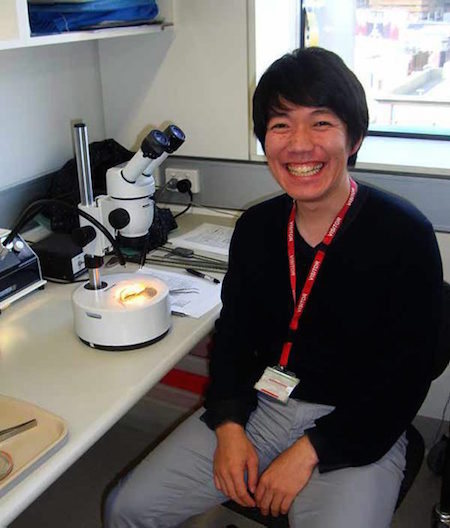Marc Abrahams's Blog, page 356
December 20, 2014
A look back at the research showing kids at malls mostly don’t like Santa
It’s nearly Christmas, a good time to look back at the research showing kids at malls mostly don’t like Santa Claus.
One way to tell a story: drunkenness + Tesla + Franklin
The folks behind the video series Drunk History honed a particular way to tell a story, using drunkenness as a frame that makes the picture more interesting. In these episodes, they tell the basic story of Nicola Tesla:
December 19, 2014
Hysterectomy in a male? A rare case report
A surgical procedure, performed on a man in India, gave birth to this unusual medical case report:
“Hysterectomy in a male? A rare case report,” Afak Yusuf Sherwani, Abdul Qayoom Shah, Abdul Majeed Wani, Ahmad Chalkoo Bashir, Ahmad Khan Bashir, Farooq Ahmad Sofi, Ashfaq Amin Wani, Wasim Lone, Ab Hamid Sherwani, Mehmood Rashid Sheikh, Raj Reshi Sharma, International Journal of Surgery Case Reports, vol. 5, no. 12, 2014, pp. 1285–1287. The authors are at District Hospital Baramulla, Kashmir, India.
Brain transplants : the implications [5 of n]
Professor Rebeka Rice of the Philosophy Department at Seattle Pacific University, US, examines the paradoxical implications of brain transplants. [see previous article in this series] The 2012 Winifred E. Weter Faculty Award Lecture for Meritorious Scholarship presents an entity called ‘Bob’ (pictured)
Bob is a human being, albeit a hypothetical one.
“
Perhaps a better way to put it is that Bob is his brain. After all, it won’t do to insist that Bob is identical with his body, since some parts of Bob’s body could go missing (he could lose an arm in an unfortunate accident, for example) and Bob would nevertheless continue to exist. What’s more, suppose Bob is to undergo a radical transplantation surgery in which a significant number of his critical organs – his heart, lungs, liver, and kidneys, say – are to be switched out for new ones. I suspect Bob will be quite nervous about the upcoming surgery, but I doubt that he will wonder who it is that will exit the operating room at the surgery’s completion. Of course it will be Bob because none of those particular organs are essential to Bob’s being Bob. On the other hand, suppose Bob is instead facing a brain transplant surgery in which the surgeon will remove Bob’s brain and replace it with someone else’s. Well, I don’t know about you, but if I am Bob, I am quite concerned about just who will be wheeled out of that operating room. Will it be Bob, or someone else?”
The lecture can be read in full here ‘Resurrection of the Body?: Physicalism and the Possibility of Life After Death‘
And a 1 hour 12 minute video of the address, from which the above illustration of Bob is taken, can be viewed here.
December 18, 2014
A scientific paper that’s baffling to outsiders
Here’s an example of a scientific paper that is baffling to people outside the author’s specialized field:
“Satyrichthys kikingeri Pogoreutz, Vitecek & Ahnelt, 2013, a junior synonym of Satyrichthys laticeps (Schlegel, 1852) (Actinopterygii: Teleostei: Peristediidae),” Toshio Kawai, Zootaxa, vol. 3900, no. 1, 2014, pp. 135–140.
Here is a photograph of the author:
Raven: Mixed Up Mixed Theory of Madmen?
Michael J. Raven of the University of Victoria presents his view of a particular view of lunatics:
 “Is Lewis’s Mixed Theory Mixed Up?” Michael J. Raven, Theoria, vol. 79, no. 1, February 2013, pp. 57–75. Quothe Raven:
“Is Lewis’s Mixed Theory Mixed Up?” Michael J. Raven, Theoria, vol. 79, no. 1, February 2013, pp. 57–75. Quothe Raven:
“My aim is to rekindle interest in David Lewis’s (1983) infamous but neglected Mixed Theory of mental states. The Mixed Theory is a mix of physicalism and functionalism designed to capture the intuitions that both Martians and abnormal human Madmen can be in pain. The Mixed Theory is widely derided. But I offer a new development of the Mixed Theory immune to its most prominent objections.”
December 17, 2014
PR statement of the week: Trust! (by Twist)
This week’s PR Statement of the Week appears in a press release issued by Mary-Ann Twist of the Journal of Consumer Research:
The statement is:
The authors found that trust in feelings influences the degree to which people believe that their feelings provide trustworthy information.
BONUS (from a year ago): The ever-intriguing Twist of Consumer Research
What’s Eating You, and/or Vice Versa: Microbes
If you enjoyed the new opera “What’s Eating You“, which was about two people and all the microbes in and on them, you will (probably) enjoy this newly published study. It’s about people, their microbes, and who eats whom:
“The microbes we eat: abundance and taxonomy of microbes consumed in a day’s worth of meals for three diet types,” Jenna M. Lang [pictured here], Jonathan A. Eisen, Angela M. Zivkovic, PeerJ, epub December 9, 2014. The authors, at the University of California, Davis, report:
“Far more attention has been paid to the microbes in our feces than the microbes in our food…. Little is known about the effects of ingested microbial communities that are present in typical American diets, and even the basic questions of which microbes, how many of them, and how much they vary from diet to diet and meal to meal, have not been answered.
“We characterized the microbiota of three different dietary patterns in order to estimate: the average total amount of daily microbes ingested via food and beverages, and their composition in three daily meal plans representing three different dietary patterns.”
Maddie Stone gives further details about the study, in Motherboard.
The opera premiered as part of the 2014 Ig Nobel Prize ceremony. You may have heard a snippet, at the tail end of the recent Science Friday radio broadcast. You can see and hear the complete opera (all three acts) in this video of the Ig Nobel ceremony:
Act 1 begins at about the 24 minute point in the video.
Act 2 begins at about the 48 minute point.
The third act — the opera’s thrilling conclusion — begins at about the 97 minute point.
BONUS: Retraction Watch reports the case of a scientific paper, about gut microbes, apparently having eaten pieces of lots of other scientific papers about gut microbes.
BONUS: The same kind of “what microbes does it eat?” analysis could be performed on other animals. This video shows a cat eating some of the contents of a seafood shop in Vladivostok, reports the Death and Taxes blog. (Thanks to Betsy Devine for bringing it to our attention):
Brain transplants : the implications [4 of n]
 Amongst the formidable complexities that would be involved in transplanting someone’s brain, lurks an enigmatic question – if it were yours, would ‘you’ go with your brain? Such questions have been examined by professor Fredrik Svenaeus, of Södertörn University, Huddinge, Sweden. The professor has a chapter in ‘The Body as Gift, Resource, and Commodity’, ( Södertörn Studies in Practical Knowledge 6, 2012) entitled ‘The Phenomenology of Organ Transplantation: How does the Malfunction and Change of Organs have Effects on Personal Identity’
Amongst the formidable complexities that would be involved in transplanting someone’s brain, lurks an enigmatic question – if it were yours, would ‘you’ go with your brain? Such questions have been examined by professor Fredrik Svenaeus, of Södertörn University, Huddinge, Sweden. The professor has a chapter in ‘The Body as Gift, Resource, and Commodity’, ( Södertörn Studies in Practical Knowledge 6, 2012) entitled ‘The Phenomenology of Organ Transplantation: How does the Malfunction and Change of Organs have Effects on Personal Identity’
“If I get a new brain I (at least possibly) become another person. In this sense, the brain is the only organ that cannot be donated; if you offer your brain to be transplanted into another body, you become a receiver, not a donor, of organs.”
But ultimately the professor reminds us that, at least until 2070 or so (when he predicts the first brain transplant might take place) we will just have to be patient for firm answers :
“To get one’s brain transplanted into a new body will probably be a different kind of personality change than going through an existential crisis. Maybe puberty, or pregnancy, could be helpful as comparisons when we consider what getting a brain transplant (getting your brain a new body) would be like, but these real-life examples will not get us very far. We simply have to wait for the event to take place to be able to answer the change-of-identity question.”
Also see: Previous related Improbable content
Brain transplants:the implications [1 of 3]
Brain transplants:the implications [2 of 3]
Brain transplants:the implications [3 of 3]
Coming soon: Brain transplants [5 of n]
Bonus: Related, in the sense of malfunctioning brain xplants …
Winningly cute animals of science
Nature magazine assembled this video of the alleged Year’s Ten Cutest Animals in Science.
Number 9 was awarded the 2014 Ig Nobel Prize for biology:
When you watch and listen to the video, pay special attention to the narrator’s very first sentence. It’s a not-so-subtle, friendly dig at Nature‘s rival journal, Science.
(Thanks to Connie Villalba for bringing this to our attention.)
Marc Abrahams's Blog
- Marc Abrahams's profile
- 14 followers




